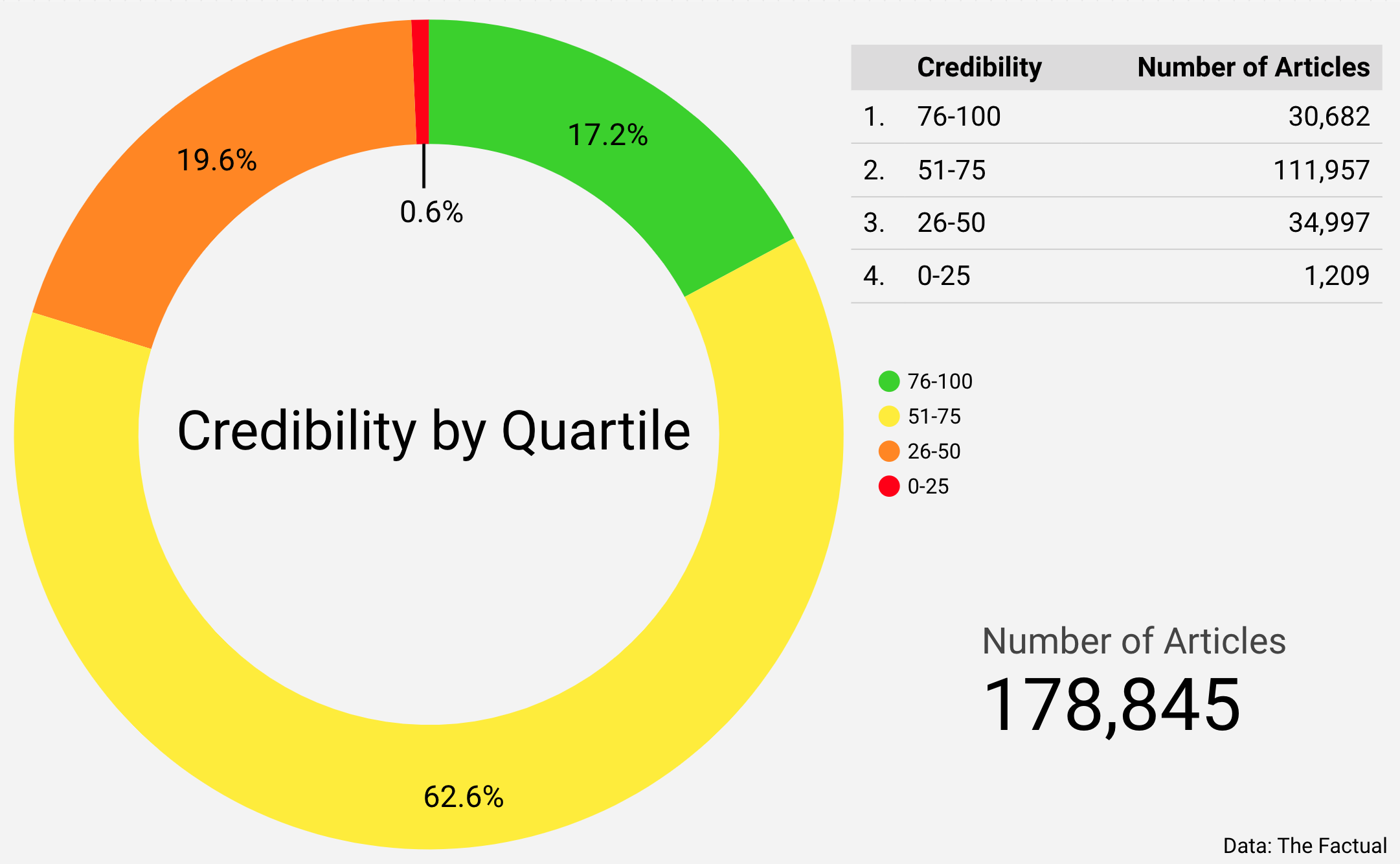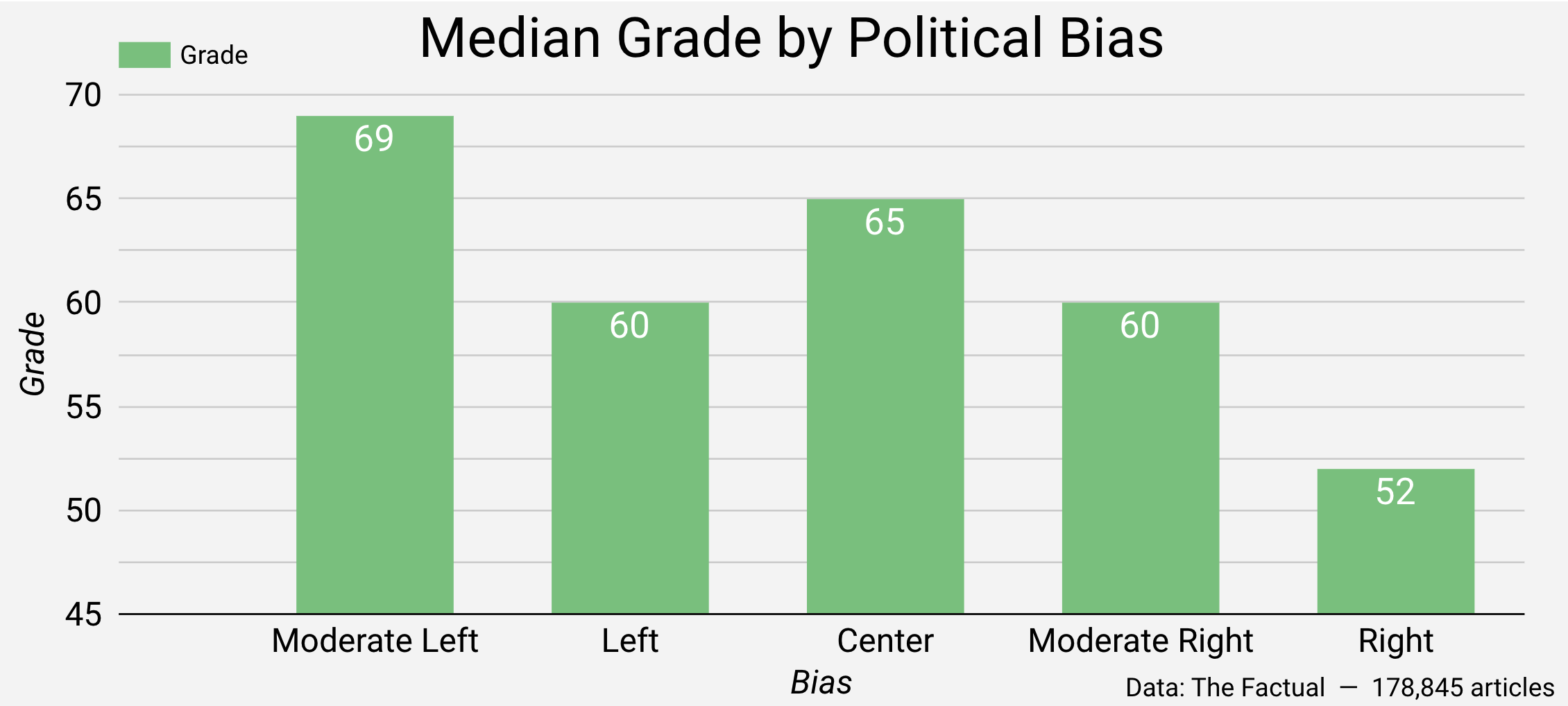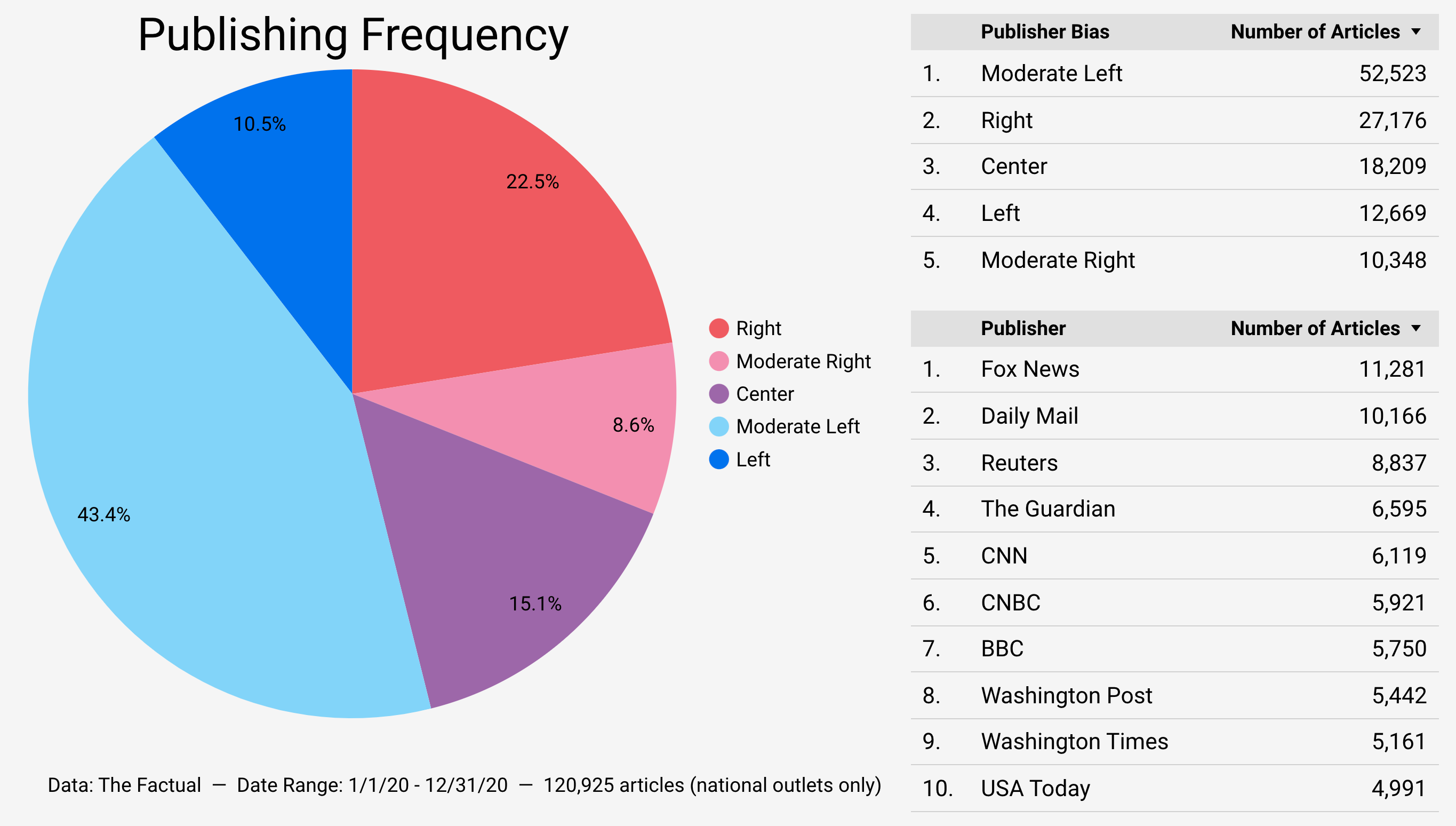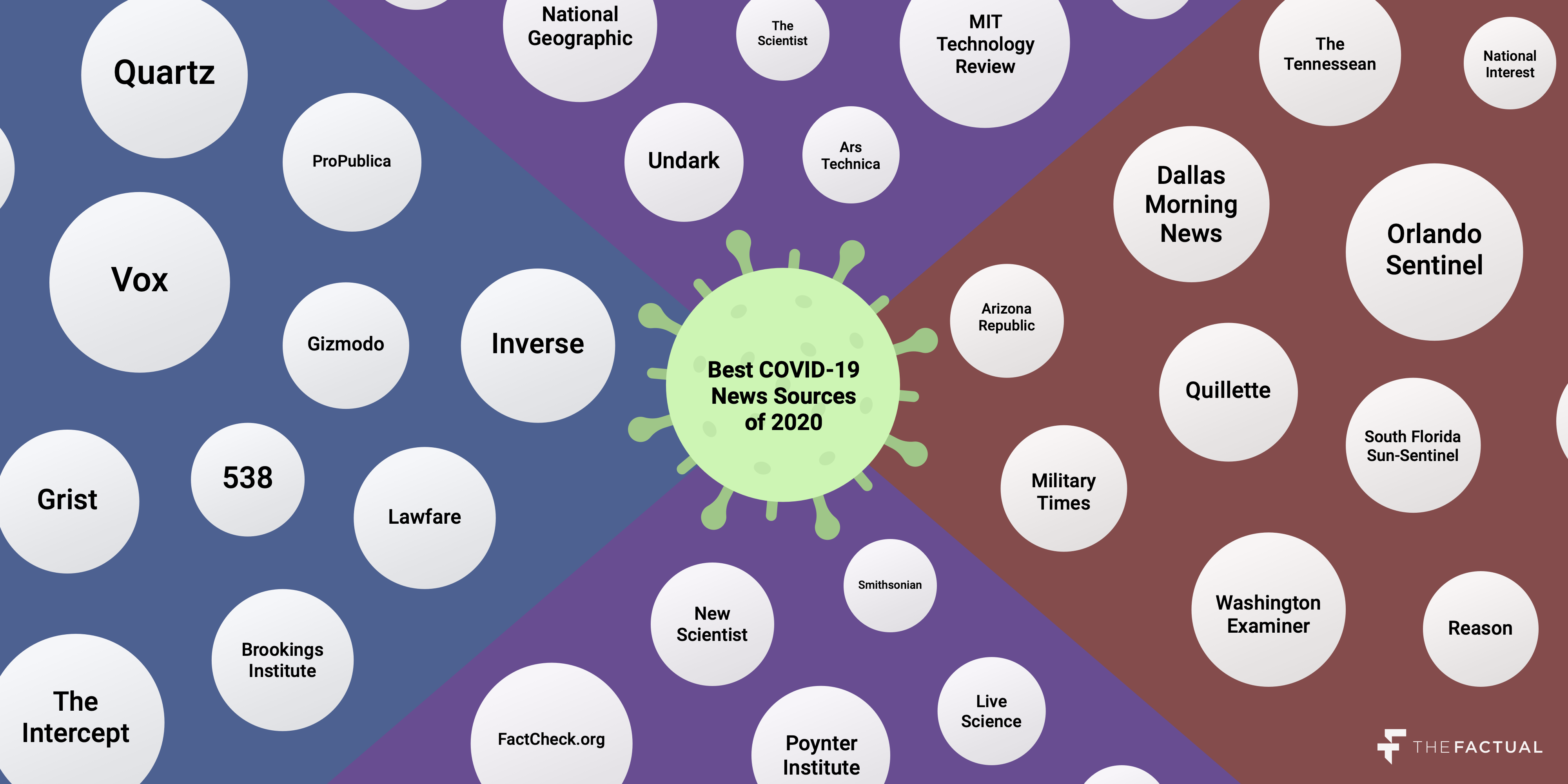Many have noted that the Covid-19 pandemic was accompanied by an “infodemic” — a flood of related news and information that played a large role in how different populations responded to the virus. Looking back at 2020, we can now see what a full year of Covid-19 coverage tells us, from who was publishing the most to who was publishing the best, most well-researched journalism.
The Factual used its AI-powered algorithm to analyze 178,845 articles about Covid-19 from across the political spectrum in 2020. The emerging data allows us to analyze trends in media output, including which liberal, conservative, and bipartisan sources have demonstrated records of generating the most credible Covid-19 news. As the U.S. passes 500,000 Covid-related fatalities, the need for fact-based, credible reporting on the virus is as vital as ever.
How The Factual Measures Credibility
The Factual’s credibility algorithm looks at four quantifiable metrics within any article to create a credibility grade out of 100 percent. This measure indicates our level of confidence that an article is credible. Anything scoring 75% or higher is highly-likely to be credible; articles falling somewhere between 50% and 75% require greater scrutiny; and articles that score less than 50% have a low probability of being credible.
Please check your email for instructions to ensure that the newsletter arrives in your inbox tomorrow.
Articles contain a lot of information, nuance, and all types of different signals that are difficult to quantify, which typically makes cross-comparison hard. That’s why The Factual’s algorithm hones in on four key factors that are measurable across most articles. These include:
- Evidence and sources – The algorithm looks at the sources linked throughout an article and at the number of direct quotations. Articles that link to high-scoring articles from numerous sources will be more likely to be credible than those that use few links, link to a narrow range of sources, or link to articles with low credibility. Similarly, articles will tend to score better if they include direct quotes of meaningful length, a sign of primary research.
- Writing tone – The algorithm uses natural language processing to gauge whether the language in an article is neutral or opinionated. Language that is overly pointed or meant to elicit an emotional response will tend to score lower than articles that present information in a neutral manner. (That’s not to say opinionated writing can’t be credible, it might just require greater scrutiny on the part of the reader.)
- Author expertise – The algorithm looks to see if the author has a history of publishing on a topic. If an article is about Covid-19, for example, the algorithm looks to see if the author has a record of publishing on health-related topics. Those who have authored numerous, high-scoring articles on a topic are more likely to score higher.
- Publisher history – A publisher’s credibility history, as measured by the millions of articles that The Factual’s algorithm has already analyzed, helps indicate whether an article is likely to be credible. For example, articles from an outlet that routinely produces low-scoring articles will be less likely to be credible.
The algorithm itself is meant to be transparent and unbiased. The Factual took extensive measures to minimize bias in the generation of scores, and anyone can see an explanation for each score using The Factual’s browser extension. Here’s how that score looks for an example article:
Using these metrics, The Factual’s algorithm analyzes close to 10,000 articles per day from across the U.S. media ecosystem and from news outlets around the world. Over 2020, we analyzed 178,845 articles that mentioned Covid-19 in the title, as measured through mentions of keywords like “covid,” “coronavirus,” or “pandemic.” This information tells us who is publishing articles on Covid-19, how often they did so, and where people are most likely to find the most credible Covid-19 news.
The Best News Sources for Covid-19
To measure which outlets were the most credible Covid-19 news sources over 2020, we looked within our dataset for news outlets with the highest median scores for which we analyzed at least 52 articles over the year-long period, or at least one article per week. Of the 965 news outlets in our dataset, 259 met this threshold.
Based on these scores, we can then highlight the best outlets from each part of the political spectrum: left, center, and right. These classifications of political bias are drawn from neutral websites like Media Bias/Fact Check and AllSides, but note that these ratings are directionally useful, not exact, given the difficulty of defining precise categories and variation between specific articles.
The news outlets that made the list represent a range of perspectives and publication types, including everything from science and tech-focused niche outlets to national and local news sites. Here’s who made the cut:
|
Left |
% | Center |
% | Right |
% | |
|
1 | The Intercept |
79 | FactCheck.org |
90 | Reason |
75 |
|
2 | Inverse |
79 | The Scientist |
89.5 | The Tennessean |
73 |
|
3 | Grist |
79 | New Scientist |
88 | Orlando Sentinel |
72 |
|
4 | ProPublica |
78 | Undark |
87 | South Florida Sun-Sentinel |
71.5 |
|
5 | Lawfare Blog |
78 | Smithsonian |
87 | Quillette |
71 |
|
6 | Brookings Institution |
78 | Poynter Institute |
82 | Military Times |
71 |
|
7 | Quartz |
77 | MIT Technology Review |
81 | Washington Examiner |
70 |
|
8 | Gizmodo |
77 | Ars Technica |
81 | National Interest |
70 |
|
9 | FiveThirtyEight |
77 | Live Science |
80 | Arizona Republic |
70 |
|
10 | Vox |
75 | National Geographic |
79 | Dallas Morning News |
68.5 |
These overall scores only tell part of the story. For a more in-depth examination of these top outlets, please see the accompanying articles broken down by political bias:
- What are the best left-leaning news sources for Covid-19?
- What are the best non-partisan news sources for Covid-19?
- What are the best conservative news sources for Covid-19?
Beyond this list, there are several areas of the data worthy of further examination. We explore three questions below:
- How much of Covid-19 news is highly credible?
- Why do articles about Covid-19 from right-leaning outlets have lower credibility on average?
- Who is publishing the majority of Covid-19 news?
Please check your email for instructions to ensure that the newsletter arrives in your inbox tomorrow.
How Much of Covid-19 News Is Highly Credible?
The 178,845 articles measured by The Factual’s algorithm in the overall dataset still only represent a portion of all the articles in the media ecosystem about Covid-19 published in 2020. Our data alone already breaks down to 490 articles a day, but not all articles are created equal. This complicates the task of finding quality, reliable information.
By our measurements, just 17.2% of the articles were highly credible — meaning they had some strong combination of our four metrics: authors with relevant expertise, reputable publishing sites, ample evidence and primary research, and neutral writing. Another whopping 62.6% fell somewhere between 50 and 75. While our algorithm suggests these articles have a lower likelihood of being credible, many are still quality articles. This is where media literacy is especially key, as only with a conscientious approach can readers discern which articles are well researched, minimally biased, and accurate. Technology can help us sort through what’s out there, but human intuition is key and will remain so.

Why Do Articles about Covid-19 from Right-leaning Outlets Have Lower Credibility on Average?
As the scores of our top news outlets reveal, there’s considerable variation in median scores across the political spectrum. Looking at the dataset more closely, we find that articles in the Moderate Left (69%) and Center (65%) categories tend to score higher than the Left and Moderate Right categories (60%), and that articles in the Right category (52%) score even lower. This shows that the right side of the spectrum tends to score worse than the left side. Does this suggest that our algorithm has a left-leaning bias or are there explanations for this trend?

Given the minimally biased design of the algorithm and the universal metrics used to calculate our credibility grades, we maintain that characteristics of the media ecosystem, not the design of our algorithm, lead to these divergent scores. There are a number of reasons that may drive scores on the left higher and scores on the right lower.
For example, there are many more news outlets in the Moderate Left category, and many of these are science/tech-focused or general news sites. Such science- and tech-based publications, such as Grist and Wired, have an advantage in terms of their topical expertise and tend to be less opinionated than political writing, therefore scoring higher. Likewise, many major news sources, such as NPR or ABC News, are classified as Moderate Left, but much of their output is routine reporting of events and is not inherently political (e.g., latest vaccination deployment figures, Covid-19 case totals); that mass of reporting will drive the Moderate Left score higher.
By contrast, there are fewer Moderate Right and Right sites, and these seem to publish more political news on average. Political news is often more opinionated, therefore tending to score lower, and low scores in these categories will have a larger relative impact since there are fewer articles and outlets. For the Moderate Left and Center, there is an abundance of science and tech-focused, somewhat niche outlets, whereas the Moderate Right seemingly lacks that same diversity. It is also worth noting that scores in the Right category especially are driven down by outlets like the Daily Mail, which published 10,166 articles with a median score of just 40%. Removing those from the dataset alone drives up the median score for all Right outlets by 4 points, to 56%.
Lastly, skepticism about Covid-19 from certain elements on the right is likely leading to less fact-based journalism than we might see otherwise.
Who Is Publishing the Majority of Covid-19 News?
When the total number of articles is categorized by political bias or publisher, it’s possible to see where most articles are coming from. For this we narrowed the dataset to 61 major, national-level outlets that are checked continuously by The Factual (meaning we are confident that we’ve captured the vast majority of their output). This subset of data accounts for 120,925 articles, or 68% of our total dataset, and reveals a few interesting facets of the data.

For starters, it shows how national-level news output is concentrated in a handful of large publications. Within this subset, 70,263 articles, or 58%, came from just 10 news outlets. This helps show how the largest, well-resourced news outlets may be capable of flooding the market with mass-produced news. Fox News, for example, was producing more than 30 articles per day on Covid-19 through 2020, or 9% of the output from these 61 outlets.
We can also see how publication output is concentrated in specific parts of the political spectrum. Left-leaning articles (meaning those from outlets with a “Left” or “Moderate Left” classifications) constitute 53.9% of all articles, while articles from right-leaning sources (from “Right” and “Moderate Right” outlets) amount to 31.1% of all articles. There are a couple reasons for this difference. First, there are far more news outlets on the left than on the right; of the 61 outlets in this subset, 32 were left-leaning, 14 were right-leaning, and 15 were from the center. Another explanation, given the politicization of the virus and differing interpretations of the disease’s severity, may be that left-leaning outlets are more likely to publish articles about Covid-19, like frequent updates on case counts and vaccine progress.
Interested in hearing more from The Factual? Our daily newsletter uses the credibility algorithm to analyze 10,000+ articles every day to highlight the very best journalism on trending topics.

